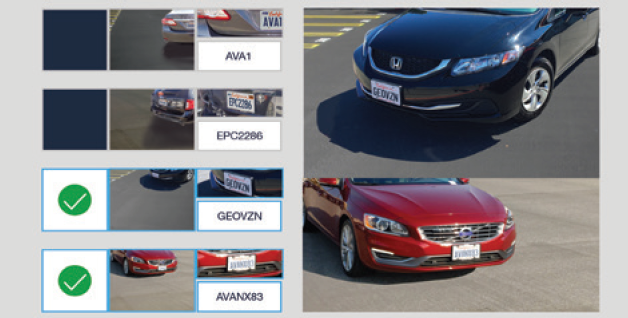Application Story: License Plate Recognition Does More than Just Read
Security cameras watch around facilities – then someone watches their images, looking for things. The more cameras, the more burden on people who get tired monitoring routine images for hours. Spotting one image at the right moment might be crucial.
Computer vision is transforming this drudgery. Cameras can do more than capture images now. With good training and image quality, AI may be able to find and recognize objects in a scene. But recognition gets more challenging when cameras point outdoors. Lighting, orientation, weather, debris, and other factors can degrade image quality.
One application where computer vision has strong potential is license plate recognition (LPR). The first step, capturing characters from a vehicle’s license plate, is straightforward. Locations for plates are common. They are usually found centered on a front bumper, or centered low on a rear car bumper or SUV hatch. Readability comes through high-contrast color schemes, legible fonts, and reflectivity. Barring off-road mud, a license plate shows itself facing a parking lot entrance in clear view.
A few more controllable factors help set the stage for LPR success. Using an intelligent video camera solves several image quality issues. Infrared LEDs can adjust shutter speed for crisp images, even in poor light on fast-moving vehicles. Pan-tilt-zoom (PTZ) auto-tracking helps with orientation. Image processing can fix bright headlights, sunlight reflections, or low-light scenes.
Moving from machine vision to LPR
Advantech sales and marketing teams see LPR emerging as a big opportunity. Advantech already has a full range of industrial machine vision solutions, and is breaking new ground in AI-enabled platforms. But tailoring indoor machine vision for LPR, with outdoor images and an AI inference engine, would take time.
Jo Sunga, Advantech’s Director of Engineering, had a proverbial two-birds-with-one-stone idea. “For security, we want to know who is coming onto our property,” says Sunga. “Are they an Advantech employee, a shipping company, an expected guest, or an unknown?” If Advantech could find LPR technology already on the market, they could get to a solution quickly.
Sunga’s team discovered GeoVision, with four critical technology pieces:
A line of IP67-rated, motorized, intelligent cameras designed for license plate capture
GV-VMS software for channels of real-time video with recording and playback tools
An LPR plug-in for GV-VMS, using Intel CPU and GPU technology for machine learning
GV-ASManager, which checks plates against a database of vehicle, owner, and driver data. It monitors access permissions, lot stay time, “hotlist” alerts, and more
“Reaching out to GeoVision made sense,” says Sunga. “They have the right technology, and their US headquarters is up the road from us in Irvine, CA.” Advantech obtained and set up two GeoVision cameras on its parking lot entrances. But instead of two computers, Sunga’s team targeted both GeoVision GV-VMS and GV-AS Manager for one Advantech platform.
Running LPR in the Advantech parking lot
For its demonstration, Advantech turned to its EPC-T2286 thin 1U embedded PC. Inside is the 8th Generation Intel® Core™ i7-8700 CPU with an Intel® UHD Graphics 630 graphics unit. Below, we see it running LPR and two video monitors side-by-side, recognizing plates on two vehicles. Note the white car, with its plate recognized even on an angled approach.
“Our setup is based on a visual motion trigger,” says Sunga. “It confirms the subject is a vehicle instead of a person, bird or other animal crossing.” Other types of triggers are possible, such as infrared beams, weight sensors, or gate controls. Once a vehicle is spotted, its license plate is recognized, logged, and matched to the database in just seconds. Sunga continues, “Plate match results can open a gate, present a routine notification, or send a security alert.”
With a few months of run time, this LPR solution is moving beyond a demonstration. It’s now a key element of Advantech’s facility security in Irvine. Plus, with the concept proven, Advantech is creating a Solution Ready Platform for LPR and evangelizing more use cases.
Improving customer experience with AI-enabled computer vision
Chris Tulk, Sr. Vertical Key Accounts Manager at Advantech, sees LPR doing more than security. “Today, with intelligent cameras and sensors tied to an AI-enabled platform for analytics, businesses are able to capture that data and put it to good use,” says Tulk. “Our LPR Solution Ready Platform allows businesses to deploy this technology easily for a variety of uses.” For example, a customer entering a parking lot can see wayfinding to open parking spaces. Or, staff can be alerted when a frequent customer arrives and greet them personally. There are also ideas like tracking digital ad campaigns through to physical location visits.
Advantech’s experience with state-of-the art Intel technology makes better solutions possible. A lot of Intel work went into enhanced multimedia performance. Advanced video transcoding and memory performance handle more camera streams with less CPU load. Integrated graphics produce cleaner display images, again with less processor overhead. More processing power is packed into less space, in compact systems like the Advantech EPC-T2286 (fan) or Advantech ARK-3530L (fanless).
Now, attention is turning to AI acceleration for computer vision. In 1999, Intel created what became the OpenCV library. From that experience, they’ve learned how to optimize processor architecture for computer vision. Vector execution units and GPUs advanced to where AI image training and inference is faster and more accurate.
Fortunately, for Advantech’s LPR solution, AI-enabled computer vision knowledge is designed in. You don’t have to know how AI reads license plates accurately. Instead, you can concentrate on using LPR for improving customer experience in and around your locations. It’s a great example of Advantech creating a high-value solution for real-world challenges.



